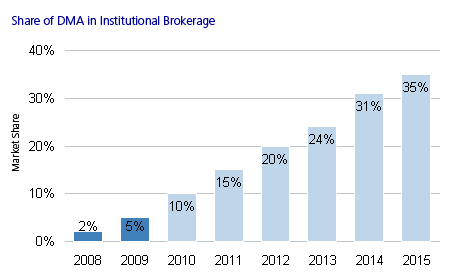Institutional Brokerages in India: Domestic Brokerages Take Up the Challenge
Abstract
Domestic institutional brokerages in India have been adopting new technology and processes and catching up with their foreign counterparts. The share of domestic brokerages in the institutional market is expected to exceed 50% by 2015.
In a new report, Institutional Brokerages in India: Domestic Brokerages Take Up the Challenge, Celent analyzes the growth of domestic brokerages in the Indian institutional market. Traditionally, the foreign brokerages have been the leading players. But now the Indian brokerages are also becoming important players. Two reasons are growth in the number of domestic clients, and increasing acceptance of Indian brokerages by foreign institutional investors.
Another important aspect is the rise in electronic trading in the industry. We expect that share of direct market access (DMA) will go from only 5% of the market in 2009 to 35% in 2015, as the domestic institutions become more adept at it and follow the lead of foreign brokerages, which use DMA extensively for both proprietary and institutional trading. At present, low-touch DMA is being adopted by the leading domestic mutual funds, which prefer it due to certain regulatory restrictions. Algorithmic trading is also being adopted, although in comparison to the leading markets such as the US and the UK, and even Japan and Singapore, India has some way to go in this regard.

“Domestic brokerages are no longer content to play second fiddle in the market and are more comfortable using the latest technology and engaging foreign vendors,” says Anshuman Jaswal, Celent Senior Analyst and author of the report.
The report looks at some of the leading Indian institutional brokerages to understand their product offering and positioning. It provides a methodology to differentiate between various brokerages and looks at an example of each type. The tremendous growth in the capital markets has also attracted the IT vendors. The second part of the report analyzes the products of these vendors, comparing their capabilities.

